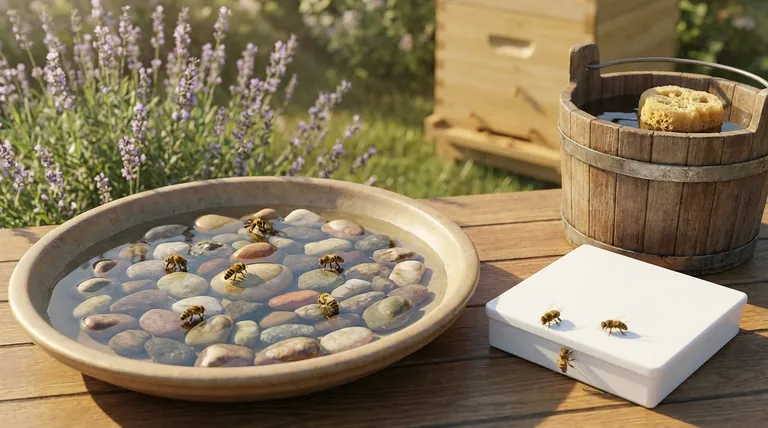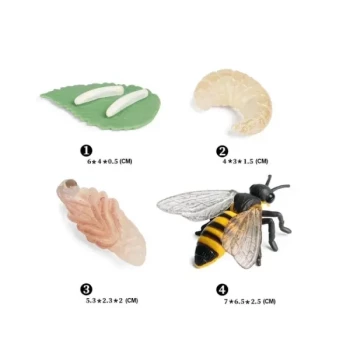To prevent bees from drowning, you must provide a safe way for them to access water without falling in. The most effective methods involve creating a landing platform or ramp within their water source using simple, non-toxic objects like rocks, marbles, sponges, or sticks, ensuring they can drink without being submerged.
Bees require water for survival but are highly susceptible to drowning because they cannot easily escape the surface tension of open water. Your primary goal is not just to provide water, but to engineer a "bee-safe" station with ample, stable surfaces for landing, drinking, and taking off.

Why Safe Water Access is Critical
Bees need water for several reasons: to dilute honey for consumption, for evaporative cooling to regulate the hive's temperature, and for larval development. However, their anatomy makes open water a significant hazard.
The Dangers of Surface Tension
A bee that falls into water is quickly trapped by surface tension. The water clings to their bodies and wings, weighing them down and making it nearly impossible to climb out or fly away.
Exhaustion and Hypothermia
Even if a bee manages to cling to the side of a container, the struggle is exhausting. Wet bees also lose body heat rapidly, leading to hypothermia and death, even if they don't fully submerge.
Methods for Creating a Bee-Safe Water Source
Creating a safe watering station is simple and can be done with common household items. The core principle is to eliminate deep, open water.
The Shallow Dish Method
This is the easiest and most popular method for gardens. Fill a shallow dish, like a birdbath or a plant saucer, with marbles, pebbles, or decorative stones. Then, add water until it partially covers the stones, leaving the tops dry for bees to land on.
The Bucket and Float Method
For a larger water source that requires less frequent refilling, use a bucket or tub. The key is to add floating objects. You can use wine corks, sponges, or pieces of wood. A cloth or rag draped over the side with one end in the water also works, as bees can land on the dry section and drink from the moist part.
The "Ladder" Principle for Feeders
When providing sugar syrup inside a hive, the risk of drowning is just as high. Modern frame feeders are often designed with built-in "ladders" or textured walls to give bees a secure foothold. If your feeder is a simple container, you must add a screen, float, or other hardware to provide a safe way for them to access the syrup.
Understanding the Trade-offs and Risks
While providing water is essential, a poorly maintained station can create new problems for your bees and the surrounding environment.
Stagnant Water and Disease
Standing water is a breeding ground for mosquitoes and can also facilitate the spread of bee diseases like Nosema. Your watering station must be cleaned and refilled with fresh water every few days to prevent contamination.
Material Safety
Only use non-toxic materials. Avoid treated wood that could leach chemicals or materials that might break down in the water. Natural stones, clean wood, cork, and food-safe plastics are reliable choices.
Location and Competition
Place your water source at least 15-20 feet away from the hive entrance to prevent it from becoming contaminated with bee feces, which can spread disease. Also, be aware that it will attract other insects and wildlife.
Making the Right Choice for Your Goal
The best method depends on your specific situation, whether you are a gardener supporting local pollinators or a beekeeper managing an apiary.
- If your primary focus is a simple garden waterer: Use a shallow dish filled with marbles or rocks; it's effective, low-maintenance, and aesthetically pleasing.
- If your primary focus is supporting multiple hives: A larger bucket with floats or a dedicated, modified birdbath is more scalable but requires diligent cleaning to prevent disease.
- If your primary focus is feeding syrup inside the hive: Always use a feeder with built-in ladders or add your own floats to prevent bees from drowning in their food.
By thoughtfully designing their water source, you provide a critical resource that strengthens your bees and prevents unnecessary loss.
Summary Table:
| Method | Best For | Key Materials |
|---|---|---|
| Shallow Dish with Stones | Gardens & Backyards | Marbles, pebbles, plant saucer |
| Bucket with Floats | Multiple Hives / Apiaries | Wine corks, sponges, wood scraps |
| Feeder with Ladders | Internal Hive Feeding | Frame feeders with textured walls, screens |
Protect Your Investment and Ensure Hive Health
Drowning is a preventable cause of bee loss that can impact your apiary's productivity. As a commercial beekeeper or distributor, maintaining a healthy colony is paramount to your success.
HONESTBEE supplies the durable, beekeeper-tested equipment you need to create safe environments for your bees. From robust frame feeders with integrated ladders to essential hive components, our wholesale-focused operations are designed to support your scale.
Let us help you build a stronger, more resilient operation. Contact our team today to discuss your specific needs and explore our full catalog of commercial beekeeping supplies.
Visual Guide

Related Products
- HONESTBEE Professional Hive Top Bee Feeder Feeding Solution
- HONESTBEE Entrance Bee Feeder Efficient Hive Front Liquid Feeding Solution for Beekeeping
- HONESTBEE Professional Entrance Bee Feeder Hive Nutrition Solution
- Professional In-Hive Frame Bee Feeder by HONESTBEE
- Boardman Entrance Bee Feeder Durable Galvanized Steel and Wood Construction for Beekeeping
People Also Ask
- What features make top feeders a reliable choice for beekeepers? A Guide to Safe, Efficient Hive Nutrition
- What are the advantages of hive top feeders? Maximize Feeding Efficiency for Your Apiary
- Why is a top feeder essential for bees? Ensure Colony Health and Efficiency
- What is a top feeder for bees? Maximize Colony Health with Efficient Feeding
- What should be done with feeders and equipment after feeding bees? Essential Steps for Apiary Health



















